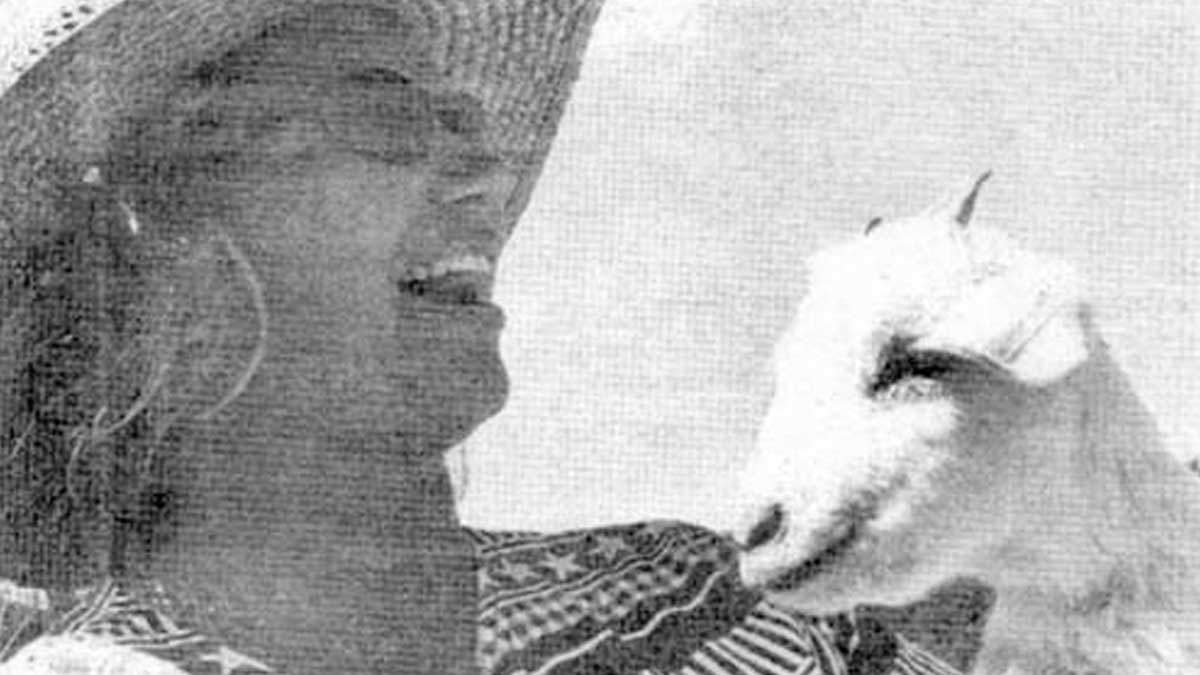
Weed-eating goats attack noxious invaders
by Jane Stebbins | Summit Daily News | July 15, 2001
FRISCO- A black-and-white border collie shifted uneasily in its crate at the Old Dillon Reservoir as the sun rose over the Continental Divide and warmed the land.
The dog whined, then scratched at the door, eager to start work herding the 500 goats penned behind bright orange plastic fencing along the water’s shore.
“Get down” muttered 19-year-old goatherd Reggie Benz. He stretched and listened; the plaintive but steady bleating of the cashmere goats outside indicated all was well. The light outside indicated it was time to get to work.
The black, gray, white and brown goats munching everything in sight along the shores of Dillon Reservoir this week could be what saves the High Country from becoming a wasteland of purple Canada thistle, lime-green leafy spurge and other noxious weeds.
“If we end up with a mono-culture, we’ll lose the insects, the birds will move on and the herbivores will leave,” said Paul Schreiner, the county’s noxious weed program director. “If that happens, it will spell doom for the native population.”
It’s happening in Montana, where 11 million acres have been overtaken by weeds. More than 88,000 acres in the White River National Forest are infested with noxious weeds, including thistle, toadflax and leafy spurge. Of primary concern in Summit County are Canada and musk thistle and the three new patches of leafy spurge Schreiner found this summer. False chamomile is everywhere, he said, as is blue flax, oxeye daisy and knapweed.
“It’s a huge problem, and it’s not a problem a lot of people recognize,” Schreiner said. The goats, he hopes, will educate people on the seriousness of non-native weeds.
Currently, Schreiner’s helping a rancher north of Silverthorne address a 35-acre plot of thistle; while waiting for the goats to arrive July 6, he spotted what he hopes isn’t a new patch of leafy spurge on a hillside in Wildernest.
Thistle are particularly invasive, as they have no native predators and proliferate easily. Any given bloom grows between 200 and 300 seeds, Schreiner said. And if that doesn’t help the plant propagate, it’ll do so via its roots. The seeds travel via wind, water and passing animals and plants. Complicating his job is the fact that weed seeds can lie dormant for years and bloom when the land is disturbed.
“Our country is all about purple mountains majesty and amber waves of grain,” he said.
Goat trivia:
- The hollow horns of a goat are never trimmed, as excess heat is released through them.
- Goats live an average of 12 years
- Male goats are billys, neutered males are wethers, females are nannies and kids are, well, kids.
- The biggest threat to goats are domestic pets, primarily dogs.
- Goats don’t eat tin cans, and only climb atop cars if they’re bored. A bored herding dog will even herd insects on the ground.
- Cashmere goats shed, and thus, don’t need to be shorn.
“But a lot of these places are being taken over. In Colorado, we have high plains, prairie grasslands, lodgepole forests, deserts, and we have noxious weeds in all these areas.. If we lose some of those, we lose a national treasure.”
A swath across the land
Four goatherds and five anxious dogs began the day by herding the goats out of their pen and along the shore where thistle grew waist deep. According to Lani Lamming, who owns the goats visiting Summit County, goats grab the prickly thistle leaves at the stalk and eat the leaf backwards to keep the stickers from getting stuck in their throats. Then they eat the bud and last, the stalk, until nothing remains but a hole in the ground.
A brown-and-white goat trotted across the service road, its eyes set on a young aspen tree. Three other kids followed.
“Bru!” she hollered. “Bring ’em back. Bring ’em back, Bru!”
The dog bolted along the edge of the scattering herd, startling the meandering goats back to the herd. “That’ll do; that’ll do! Bru! Down!”
The dog hit the ground, its eyes darting between Benz and the goats.
“You have to make them stop,” Lamming said of the dogs. “They’re workaholics. They’ll work till they drop dead; it’s in their heart.”
The dogs are allowed to eat all day ; although the instinct to herd is stronger. Lamming feeds them a high-protein food made for working dogs and tops it off with bacon and hamburger if they start to look a little thin.
The dogs might not have time in their lives to eat, but-it’s all the goats do. If they go more than an hour without eating, they’re voracious, Benz said.
The goats will graze for about four hours in the morning as the dogs nervously keep watch, slinking along the perimeter of the herd, eyeing every move. As temperatures rise, the goats flop onto the ground and chew their cud. Because time is irrelevant on the range, Lamming doesn’t wear a watch. She watches the goats’ conduct and monitors the growth of their hair, which grows longer as the days grow shorter.
And she lets them be to do their job. Unlike their human counterparts, the ruminants use more than their eyes to locate weeds. They snort and sneeze, presumably to eliminate any lingering smells before seeking out more weeds.
“One place, we thought we stayed too long,” Lamming said. “We thought we’d conducted shocking management practices. But some of the worst mistakes we thought we’d made got some of the best results. The goats know how to work within an ecosystem.”
She may find that to be the case at Old Dillon Reservoir, where last week her goats nibbled away at thistle and aspen and lodgepole pine.
Saturday, as the sun sank and temperatures dropped, the animals got up and ran, en masse, to the highest point they could find -a fallen log on a grassy knoll- and scrambled to the top. A large gray goat butted others off its hill, and the smaller kids spun and tumbled and charged the hill again. They eventually settled down to eating again. An occasional bleat and the sound of ripping grass were all that could be heard.
Serendipity
It was serendipity that brought Lamming and her herd of 2,000 goats together.
She was an undergraduate at Mesa State College in Grand Junction and writing a paper on Russian knapweed, a noxious weed in that area of the state. Wanting to learn more about the creeping perennial, she was referred to Colorado State University in Fort Collins, where a professor had a project and a stipend, but no one to do the job. Herding sheep in western Colorado would earn Lamming a master’s degree.
Later, she was introduced to a herd of goats and the dogs that drive them -an ancient method of eliminating weeds now making its debut in the United States.
“The instant I saw the animal, I knew it was right,”she said. “I got a loan, my boys pooled all their college savings, and we bought the goats, a cell phone and a fax machine.”
Lamming has a special bond with the dogs, she said, and the dogs with the goats. The three entities in turn, work with the land.
“I like being on the land,” said Lamming. “I like moving around in a gypsy kind of way. The land is very friendly. I don’t have that sense in the city, when you’re stuck in traffic and under attack. And I think the land likes it, too. We’re working together.”
Her purpose, she said, is to feed the dogs and open the doors to the horse trailers to let the goats out. She’s also there to ensure the goats’ safety, particularly from domestic dogs. A bear is usually just passing through, but a dog’s instinct is often to kill. A malamute that got loose in one weed project ran through the herd, breaking the necks of 17 goats.
Lamming doesn’t dwell on the occasional losses. The best part of her job is the goats, the people she meets and the gentle approach to eradicating invasive weeds.
“Goats are the perfect recycling machine,” she said, watching a gray wether -a neutered billy goat -tear into a tall thistle. “Isn’t that the most beautiful thing you’ve ever seen? They have no waste products. They shed cashmere in March, they give us baby goats and they fertilize the land.”
They chew the weeds so thoroughly, an estimated 3 percent of the seeds pass through their system. If the goats are brought through the area again next summer, they’ll further weaken the weeds and allow native grasses to return. Schreiner will re-vegetate the land with native grass seed; the goats will tramp it into the earth to grow.
“Scooter! Look back! Look back!” The dog, barely visible above the grasses along the reservoir, leaped up in the air and turned, its ears alert and eyes looking everywhere. He spotted the errant kid and charged at it, snapping at its heels as it scampered back to. the retreating herd.
“Scooter! That’ll do. Down,” she ordered the dog. “It’s an adventure every day.”
Lani Lamming kids around for the camera and her adoring public.
